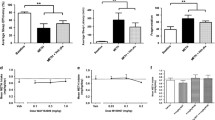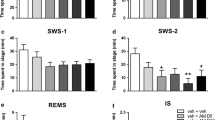Abstract
The effects of ritanserin, a 5-hydroxytryptamine-2 (5-HT2) receptor antagonist, and chlordiazepoxide, a benzodiazepine agonist, on sleep-wakefulness disturbances in rats after acute administration of cocaine and after discontinuation of chronic cocaine treatment were examined. Intraperitoneal (IP) injection of chlordiazepoxide (10 mg/kg) but not ritanserin (0.63 mg/kg) prevented the increase of wakefulness (W) and the reduction of light slow wave sleep (SWS1) and deep slow wave sleep (SWS2) induced by an acute injection of cocaine (20 mg/kg IP). Daily injection of cocaine (20 mg/kg for 5 days, then 30 mg/kg for 5 days IP) at the onset of the light phase elicited an increase of W and a concomitant decrease of SWS1, SWS2 and paradoxical sleep (PS) in the light phase, followed by a rebound in SWS2 and PS in the subsequent dark phase. Following cocaine discontinuation, the circadian distribution of sleep-wakefulness states remained disturbed in saline-treated rats for at least 5 days. Both ritanserin (0.63 mg/kg IP/day) and chlordiazepoxide (10 mg/kg IP/day) reduced the alteration in the distribution of W and SWS2 throughout the light-dark cycle from the first day of administration on, but failed to prevent PS alterations. The mechanisms by which both compounds exert their effect are probably quite different. For chlordiazepoxide sedative and sleep-inducing properties probably play a major role. In contrast, for ritanserin SWS2-increasing properties and its ability to reverse preference for drugs of abuse without inducing aversion might be key factors.
Similar content being viewed by others
References
Adam K, Oswald I (1989) Effects of repeated ritanserin on middle-aged poor sleepers. Psychopharmacology 99:219–221
Awouters F, Niemegeers CJE, Megens AHP, Meert TF, Janssen PAJ (1988) The pharmacological profile of ritanserin: a very specific central serotonin S2-antagonist. Drug Dev Res 15:61–73
Barr GA, Sharpless NS, Cooper S, Schiff SR, Paredes W, Bridger WH (1983) Classical conditioning, decay and extinction of cocaine-induced hyperactivity and stereotypy. Life Sci 33:1341–1351
Bjorvatn B, Ursin R (1990) Effects of zimeldine, a selective 5-HT uptake inhibitor, combined with ritanserin, a selective 5-HT2 antagonist, on waking and sleep stages in rats. Behav Brain Res 40:239–246
Cole SO (1986) Effects of benzodiazepines on acquisition and performance: a critical assessment. Neurosci Biobehav Rev 10:265–272
Costall B, Kelly MH, Naylor RJ, Onaivi ES (1989) The actions of nicotine and cocaine in a mouse model of anxiety. Pharmacol Biochem Behav 33:197–203
Davenne D, Dugovic C, Franc B, Adrien J (1989) Ontogeny of slow wave sleep. In: Slow wave sleep: physiological, pathophysiological and functional aspects. Raven Press, New York, pp 21–30
Depoortere H, Decobert M, Granger P, Riou-Merle F (1986) Hypnotics: clinical value of pharmaco-EEG methods. Neuropsychobiology 16:157–162
Dugovic C, Leysen JE, Janssen PFM, Wauquier A (1989a) The light-dark cycle modulates the effects of ritanserin on sleep-wakefulness patterns in the rat. Pharmacol Biochem Behav 34:533–537
Dugovic C, Wauquier A (1987) 5-HT2 receptors could be primarily involved in the regulation of slow-wave sleep in the rat. Eur J Pharmacol 137:145–146
Dugovic C, Wauquier A, Leysen JE, Marrannes R, Janssen PFM, (1989b) Functional role of 5-HT2 receptors in the regulation of sleep and wakefulness in the rat. Psychopharmacology 97:436–442
Emmett-Oglesby MW, Mathis DA, Moon RTY, Lal, H (1990) Animal models of drug withdrawal symptoms. Psychopharmacology 101:292–309
Feinberg I, Fein G, Walker JM, Price LJ (1977) Flurazepam effects on slow-wave sleep: stage 4 suppressed but number of delta waves constant. Science 198:847–848
File SE (1984) Behavioural pharmacology of benzodiazepines. Prog Neuropsychopharmacol Biol Psychiatry 8:19–31
Gaillard JM, Schulz P, Tissot R (1973) Effects of three benzodiazepines (nitrazepam, flunitrazepam and bromazepam) on sleep of normal subjects, studied with an automatic sleep scoring system. Pharmacopsychiatry 6:207–217
Gawin FH (1991) Cocaine addiction: psychology and neurophysiology. Science 251:1580–1586
Gawin FH, Kleber HD (1986) Abstinence symptomatology and psychiatric diagnosis in cocaine abusers. Arch Gen Psychiatry 43:107–113
Gillin JC, Swerdlow N, Darko, D, Lam R, Gierz M, Berkowitz A (1989) Depression ratings and all-night EEG sleep studies during acute withdrawal in cocaine and amphetamine addicts. Sleep Res 18:178
Goeders NE (1990) The effects of chronic cocaine administration on brain neurotransmitter receptors. Drug Dev Res 20:349–357
Hall WC, Talbert RL, Ereshefsky L (1990) Cocaine abuse and its treatment. Pharmacotherapy 10:47–65
Halperin JM, Miller D, Iorio LC (1981) Sleep-inducing effects of three hypnotics in a new model of insomnia in rats. Pharmacol Biochem Behav 14:811–814
Hill SY, Mendelson WB, Bernstein DA (1977) Cocaine effects on sleep parameters in the rat. Psychopharmacology 51:125–127
Idzikowski C, Mills FJ, Glennard R (1986) 5-Hydroxytryptamine-2-antagonist increases human slow wave sleep. Brain Res 378:164–168
Johanson CE, Fischman MW (1989) The pharmacology of cocaine related to its abuse. Pharmacol Rev 41:3–52
Kales A, Kales JD, Bixler EO, Scharf MB, Russek E (1976) Hypnotic efficacy of triazolam: sleep laboratory evaluation of intermediate-term effectiveness. J Clin Pharmacol 16:399–406
Leysen JE, Gommeren W, Van Gompel P, Wynants J, Janssen P, Laduron PM (1985) Receptor binding properties in vitro and in vivo of ritanserin: a very potent and long-acting serotonin 5-HT2 antagonist. Mol Pharmacol 27:600–611
McElroy JF, Fleming RL, Feldman RS (1985) A comparison between chlordiazepoxide and CL 218, 872 — a synthetic nonbenzodiazepine ligand for benzodiazepine receptors on spontaneous locomotor activity in rats. Psychopharmacology 85:224–226
Meert TF, Janssen PAJ (1989) Psychopharmacology of ritanserin: comparison with chlordiazepoxide. Drug Dev Res 18:119–144
Meert TF, Awouters F, Janssen PAJ (1990a) The preference for alcohol and cocaine is virtually abolished by the 5-HT2 receptor antagonist ritanserin. Eur J Pharmacol 183:1924
Meert TF, De Haes PLAJ, Vermote PCM, Janssen PAJ (1990b) Pharmacological validation of ritanserin and risperidone in the drug discrimination test procedure in the rat. Drug Dev Res 19:353–373
Meert TF, Awouters F, Niemegeers CJE, Schellekens KHL, Janssen PAJ (1991) Ritanserin reduces abuse of alcohol, cocaine and fentanyl in rats. Pharmacopsychiatry 24:159–163
Mendelson WB, Cain M, Cook JM, Paul SM, Skolnick P (1983) A benzodiazepine receptor antagonist decreases sleep and reverses the hypnotic actions of flurazepam. Science 219:414–416
Michel F, Klein M, Jouvet D, Valatx JL (1961) Etude polygraphique du sommeil chez le rat. CR Soc Biol (Paris) 155:2389–2392
Monti JM, Alterwain P (1991) The effects of ritanserin on mood, sleep and alcohol intake in chronic alcoholics. Biol Psychiatry 29:500S
Monti JM, Pineyro G, Orellana C, Boussard M, Jantos H, Labraga P, Olivera S, Alvarino F (1990) 5-HT receptor agonists 1-(2,5-dimethoxy-4-iodophenyl)-2-aminopropane (DOI) and 8-OH-DPAT increase wakefulness in the rat. Biog Amines 7:145–151
Nomikos GG, Spyraki C (1988) Effects of ritanserin on the rewarding properties of d-amphetamine, morphine and diazepam revealed by conditioned place preference in rats. Pharmacol Biochem Behav 30:853–858
Paiva T, Arriaga F, Wauquier A, Lara E, Largo R, Leitao JN (1988) Effects of ritanserin on sleep disturbances of dysthymic patients. Psychopharmacology 96:395–399
Post RM, Rose H (1976) Increasing effects of repetitive cocaine administration in the rat. Nature 260:731–732
Post RM, Gillin JC, Wyatt RJ, Goodwin FK (1974) The effect of orally administered cocaine on sleep of depressed patients. Psychopharmacologia 37:59–66
Post RM, Lockfeld A, Squillace KM, Contel NR (1981) Drug-environment interaction: context dependency of cocaine-induced behavioral sensitization. Life Sci 28:755–760
Radulovacki M, O'Connor SD, Ticho S, Vugrincic C, Lekovic M (1990) Effects of cocaine on sleep in rats. Soc Neurosci Abstr 16:748
Ruiz-Primo E, Haro R, Valencia M (1989) Polysomnographic effects of ritanserin in insomniacs: a crossed double-blind controlled study. Sleep Res 18:72
Silhol S, Glin L, Gottesmann C (1991) Study of the 5-HT2 antagonist ritanserin on sleep-waking cycle in the rat. Pharmacol Biochem Behav 41:241–243
Wallach MB, Gershon S (1971) A neuropsychopharmacological comparison ofd-amphetamine, L-DOPA and cocaine. Neuropharmacology 10:743–752
Wood DM, Lal H (1987) Anxiogenic properties of cocaine withdrawal. Life Sci 41:1431–1436
Yoshimura K, Inoue Y, Sawada, T, Yamamoto K (1980) Neuropharmacological studies on drug dependence (IV) changes in spontaneous motor activity, EEG and brain monoamines during the period of dependence development and of abrupt withdrawal in rats. Jpn J Pharmacol 30:197P
Author information
Authors and Affiliations
Rights and permissions
About this article
Cite this article
Dugovic, C., Meert, T.F., Ashton, D. et al. Effects of ritanserin and chlordiazepoxide on sleep-wakefulness alterations in rats following chronic cocaine treatment. Psychopharmacology 108, 263–270 (1992). https://doi.org/10.1007/BF02245110
Received:
Revised:
Issue Date:
DOI: https://doi.org/10.1007/BF02245110




